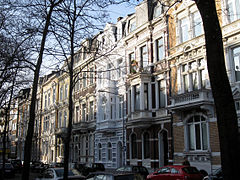Frankenberg district
|
Frankenberg
City of Aachen
Coordinates: 50 ° 46 ′ 6 ″ N , 6 ° 6 ′ 24 ″ E
|
|
|---|---|
| Height : | approx. 170 m |
| Postal code : | 52066 |
| Area code : | 0241 |
The Frankenberger Viertel or simply Frankenberg was a district of the city of Burtscheid and came to Aachen in 1897 through the incorporation of Burtscheid . The quarter is north of the Aachen – Cologne railway line between the actual town center of Burtscheid and Forst in Aachen, North Rhine-Westphalia . It is known for the Frankenberg (or Frankenburg) Castle .
history
The Frankenberger Viertel was built between 1870 and 1920 a. a. continuously built on the premises of Aktiengesellschaft Frankenberg . During the founding period , historicist facades were created according to neoclassicism ( neo-renaissance , neo-baroque , neo-gothic and mixed forms), then facades in non-historicist fantasy styles , art nouveau and at the end of time again strict forms. More than 250 monuments have been identified in the area of the Frankenberg corporation alone . The area is to the north and east of the pre-existing castle and park. Important features are two major road axes (Kaiserallee, today Oppenhoffallee; and Viktoriaallee), a market square (Neumarkt) and the Catholic Church of the Sacred Heart of Jesus . The Beverbach goes underground in the Obere Drimbornstrasse and now flows through the Frankenberg district in pipes.
Steffensviertel and Viktoriaviertel are older and do not belong to the Frankenberg public limited company. Since they connect to the area north of Lothringerstraße and Oppenhoffallee, they are often associated with it, especially by real estate and apartment brokers. The Viktoriaviertel is mainly characterized by its former large factories with a total of well over 1,500 employees who settled on the banks of the Beverbach from the middle of the 19th century. These include above all the cloth factory Pastor / Neuwerk , the cloth factory Aachen formerly Süskind and Sternau AG , the cloth factory J. Cüpper & Sohn and the stock spinning mill Aachen. After the first city expansion outside the outer wall ring, the Rehmviertel, which has even larger public spaces, urban planning and street profiles, but above all the lack of public green spaces and, last but not least, the heavily filled block interiors of the Steffens- and Viktoriaviertel clearly show the strong economic interests of planning and planning Handwriting. After the Second World War, the Steffensviertel shows two rudimentary "syringe stations" on Friedrichstrasse. In addition to a playground, the Viktoriaviertel has only had a larger public park since 2009, which was created with the construction of the Aachen Justice Center.
After these three extensions, the Prussian Alignment Lines Act came into force in 1875 , which transferred the alignment planning from the Kingdom of Prussia to the (here two) participating communities in the first phase of the projection of the area of the Frankenberger Quarter, the 4th urban expansion. In the course of the development of the Frankenberger Quarter around 1880 the thermal springs of the Lower Burtscheider source group were captured or sealed, which up to this time flowed freely as pool springs on the banks of the Gillesbach and Warm Bach .
Individual evidence
- ↑ Law on the unification of the municipality of Burtscheid with the municipality of Aachen of March 29, 1897 together with the contract (pdf; 19 kB)
- ↑ List of monuments of the city of Aachen (PDF; 129 kB)
- ^ Peter Ruhnau: The Frankenberger Quarter in Aachen (= workbooks of the Rhineland State Conservator. ) Rheinland-Verlag, Cologne 1976, ISBN 3-7927-0245-2 , p. 15
literature
- Peter Ruhnau: The Franconian Quarter in Aachen (= workbooks of the State Conservator Rhineland. ) Rhineland-Verlag, Cologne 1976, ISBN 3-7927-0245-2 . (also dissertation, RWTH Aachen)
- Peter Ruhnau: The Frankenberg Quarter in Aachen. A terrain company from the Wilhelminian era operates urban development. In: Gerhard Fehl, Juan Rodriguez-Lores (Ed.): City extensions 1800–1875. From the beginnings of modern urban planning in Germany (= city, planning, history. Vol. 2). Christians, Hamburg 1983, ISBN 3-7672-0807-5 , pages 235-251.
- Silke Niewenhuis: Town houses and villas in Aachen: Aachen - Frankenberger Viertel. Volume 1, Aschenbeck, Bremen 2009, ISBN 978-393940155-1 .





